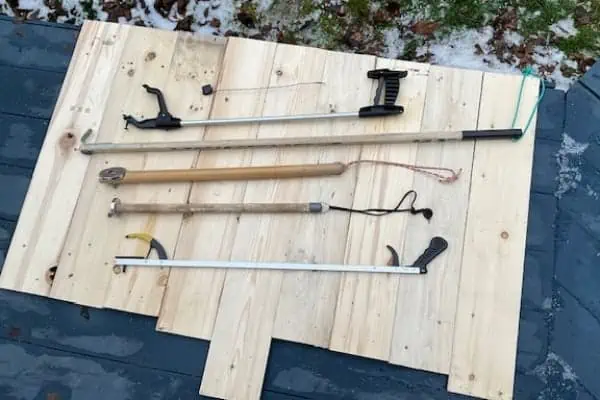Over the years I’ve been out in the rain. I’ve seen
people who wear raingear from ultra-expensive Gore-Tex to disposable vinyl rain ponchos, or even garbage bags.
Huddling under a tarp is another common sight.
How well the garbage bag/vinyl poncho crowd did depended on how long the rain fell, their attitude, and definitely their level of physical activity. While some level of activity is necessary to keep warm, more than the minimum results in the wearer sweating like he’s in a sauna. This results in one ending up cold and wet anyway, because the moisture coming off your body cannot evaporate through the non-breathing plastic. Gore-Tex, H2No, AquaTex and a number of other similar products are described as “waterproof and breathable”, which is generally true. In this material there is a membrane between the layers of the garment which allows the smaller water molecules from perspir- a – tion out, while blocking the larger water molecules of rain from coming in. The garments are made of nylon or some other manufactured material on the outside with the membrane sewn between the outer and inner layers which is often a type of fi ne mesh or netting. The nylon outer layer is also resistant to damage and is wind-proof. These products are available from the ground up, including boots, socks, pants (bibs or regular), jackets, gloves, and hats. They are also available insulated or uninsulated. My choice is always uninsulated, allowing me to decide what to wear under them to suit the weather.
Gore-Tex and similar products are kept in top shape and waterproof by washing hot and drying in the dryer. If you can afford it, go for pants with side-vents, hooded jackets with two-way zippers, and arm-pit openings. These allow venting to keep you comfortable.
If you are a person that doesn’t heat up easily or your activity is fairly sedentary, like driving a boat, standing still, fishing, or calling moose then the older style heavy vinyl or even rubberized canvas rain gear may work for you. These garments have been tested over the years by commercial fi shers and are very tough as well as functional. They are defi nitely much lower in price than any of the Gore-Tex-type products. These garments are also much better near a fire because a spark or cinder on a nylon/Gore-Tex garment will melt right through in an instant.
Your rain gear should also include calf-high, slip-on rubber/ neoprene boots, and wool or neoprene gloves when it’s colder. Either of these glove-types will keep your hands warm, even when they are wet.
A hat worn with a hood is very important because it prevents heat loss through an uncovered head. A wool or polypro toque keeps you warm when it’s wet. A peaked cap helps to keep the rain out of your face and a hat with a brim all the way around is very stylish but prevents putting up the all-important hood on the jacket.




